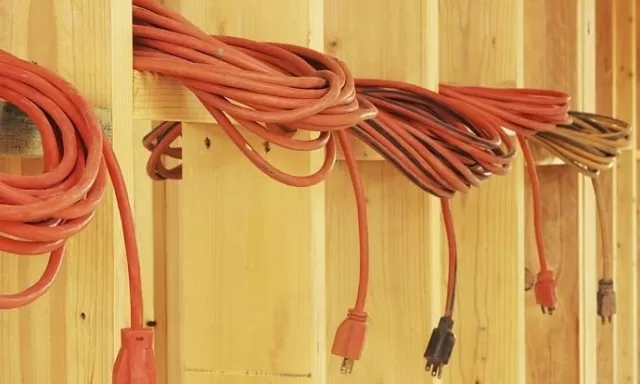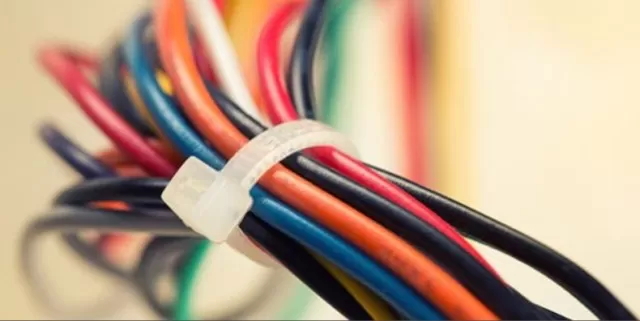It’s no secret that the number of electronic devices we own keeps growing, and along with them comes a tangle of cords in various lengths, shapes, and sizes.
Additionally, we often need power cords to extend the reach of appliances or for outdoor power equipment.
To maintain an organized and efficient living space, it’s crucial to establish a system for managing cords, whether they’re currently in use or not. Our collection of power cord organizing hacks will not only help you maintain your sanity but also ensure safety at home.
By implementing these hacks, you’ll save valuable time searching for the right cords and avoid unnecessary expenses on replacements.
Ways to Organize Power Cords

Bundle Them Up.
Repurpose the elastic bands that were once used for baby bottles or sippy cups to keep your cords organized.
These stretchable bands are perfect for bundling medium-sized cords and securing them neatly. If you don’t have any of these bands, you can easily find affordable options online.
Customize the bands by adding labels with information about the cord length and usage, so you can easily identify them without having to unravel each cord.
Conceal in Boxes.
To maintain a tidy and organized environment in your Home Office, Living Room, or bedroom, it’s important to conceal cords as much as possible.
A cable management box is an excellent solution to hide a bulky power strip and minimize the appearance of multiple plugs. Simply place the box under your desk or near the TV stand, and witness the visual clutter disappear.
Utilize Wall Space.
Make use of blank wall space in your basement, garage, or shed by installing a wall-mounted rack or towel bar.
Loop extension cords onto the rack or bar, which comes in handy for occasional home projects. This method prevents cords from taking up unnecessary shelf or floor space.
Hang a basket above the rack to store power strips and connectors, keeping them within easy reach.
Belt Organizer Solution.
Give new life to a rotating tie or belt organizer by using it to keep your cords in order.
Each cord can be draped on individual hooks, and the organizer can be hung in a location that is out of reach for little ones. To easily identify each cord, label them with different colored electrical tape.
This way, you can quickly find the cord you need when you need it.
Secure with Zip Ties.
If you have extra zip ties lying around, they can be used to secure wound-up cords.
While zip ties can be narrow and difficult to label directly, you can attach paper key tags to them for easy identification. Use a pen to indicate the length and type of each cord before attaching the zip ties.
Once organized, place the cords in a tote with a lid and label the tote as well.

Hang on.
Hooks Individual U-hooks are sturdy and practical for cord management.
Install them vertically on a wall at a height of your choice and loop the cords onto each hook. Stagger the hooks slightly to prevent the cords from tangling.
Similar to the zip tie method mentioned earlier, secure the cords with zip ties and label them using paper key tags.
Clip It.
For smaller cables like phone or laptop chargers, use adhesive clips that can be attached to any surface.
These clips come in various styles and can be purchased as a strip or individually. Attach them to the side of your nightstand, desk, or kitchen island to keep the cords in place and easily accessible.
Clamp Cords.
Invest in cable clamping devices designed to secure bundles of cords.
These clamps have lock-and-release teeth and are a durable and reusable alternative to zip ties. Once your power cords are wrapped together with the clamp, store them in totes or tool bags that are easily accessible.
Portable Cord Organizer.
Consider using a portable tech cord organizer when you need to take chargers on the go.
These zippered pouches come with elastic loops to keep cables tidy inside. They provide enough room for adapters, portable chargers, and headphones, allowing you to have everything you need in one organized place.
Hook-and-Loop Tape.
Hook-and-loop tape, also known as Velcro, is a versatile and affordable solution.
Cut off a piece and wrap it around any cord that needs containment. This type of tape is easy to take on and off, making it ideal for organizing cords that are frequently used, such as hair tools, tech gadgets, or kitchen appliances.
It functions similarly to zip ties but is more practical for cords that are constantly in use.
Tips for Safely Using Power Cords

In addition to organizing your power cords, it’s essential to use them safely.
Here are some tips from the U. S.
Consumer Product Safety Commission:
Avoid Overloading: Check the wattage rating of your extension cords and ensure that you don’t plug in devices that draw more power than the cord’s maximum capacity.
Keep Cords Loose: Never use coiled or looped cords, and avoid covering them with objects like rugs.
If furniture might push against a plug, use angled extension cords to prevent damage.
Replace Damaged Cords: If you notice cracks in the plastic casing of a cord or if it feels hot or soft when in use, it’s time to replace it with a new one.
Safety should always be a priority when using power cords.
By following these tips and implementing the cord organization ideas mentioned earlier, you can maintain a clutter-free space while ensuring the safety of your electrical cords.
*The information is for reference only.